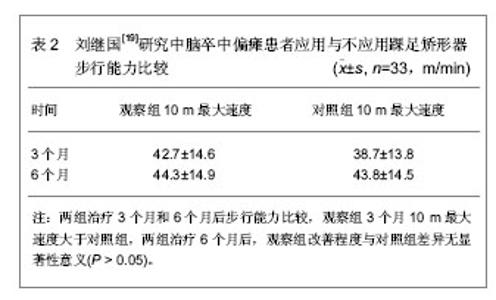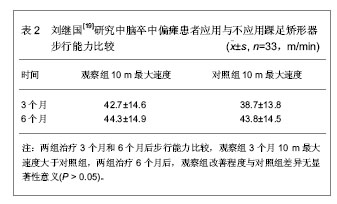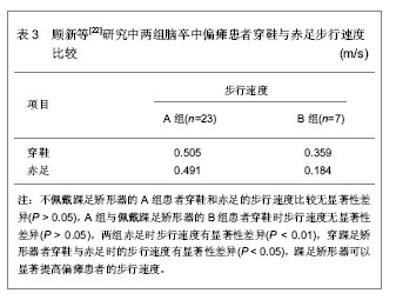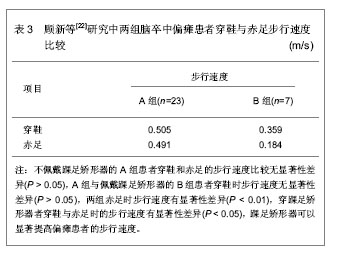| [1] Thijssen DH,Paulus R,van Uden CJ,et al.Decreased energy cost and improved gait pattern using a new orthosis in persons with long-term stroke.Arch Phys Med Rehabil.2007; 88(2):181-186.[2] 李铁山,刘艳林,关蕾,等.早期穿戴弹力悬带矫形器对脑卒中患者步行功能恢复的影响[J].中华物理医学与康复杂志,2008,30(9): 631-634.[3] 何静杰,张通,朱镛连,等.踝足矫形器对偏瘫患者异常步态模式的影响[J].中华神经科杂志,2003,36(2):122-125.[4] 马英文,刘捷,殷延玲,等.自制踝足矫形器对急性脑血管病患者下肢运动功能的影响[J].中国临床康复,2004,8(28):6194.[5] Dettmann MA,Linder MT,Sepic SB.Relationships among walking performance, postural stability, and functional assessments of the hemiplegic patient.Am J Phys Med.1987; 66(2):77-90.[6] 杨俊玲,徐应乐,魏毅,等.下肢矫形器疗法对脑卒中偏瘫患者运动功能恢复的影响[J].中国临床康复,2005,9(9):6-7.[7] Gowland C,Stratford P,Ward M,et al.Measuring physical impairment and disability with the Chedoke-McMaster Stroke Assessment.Stroke.1993;24(1):58-63.[8] 徐光青,兰月,毛玉瑢,等.脑卒中患者步行时下肢运动的三维运动学研究[J].中华医学杂志,2007,87(41):2889-2892.[9] Lehmann JF,Condon SM,Price R,et al.Gait abnormalities in hemiplegia: their correction by ankle-foot orthoses.Arch Phys Med Rehabil.1987;68(11):763-771.[10] 尤年兴,沈玄霖,石志革,等.前置式与后置式踝足矫形器对脑卒中患者步行功能恢复的影响[J].神经疾病与精神卫生,2010,10(5): 472-473.[11] 何静杰,张通,朱镛连,等.踝足矫形器对偏瘫患者异常步态模式的影响[J].中华神经科杂志,2003,36(2):122-125.[12] 胡莹媛.小儿脑瘫康复常用矫形器及其它辅助器具的临床实践[J].中国康复理论与实践,2003,9(9):454-456.[13] 高怀民,瓮长水,于增志.重度脑卒中偏瘫患者步行功能的重建[J].中国康复医学杂志,1999,14(3):117-118.[14] 中华神经科学会中华神经外科学会.各类脑血管疾病诊断要点[J].中华神经科杂志,1996,29(6):379-380.[15] 瓮长水,高怀民,于增志,等.积极康复程序对急性脑卒中偏瘫患者步行能力的影响[J].中国康复医学杂志,2000,15(4):202-204.[16] 中国知网.中国学术期刊总库[DB/OL].2013-2-27. https://www.cnki.net[17] SCI数据库.Web of Sciencevia ISI Web of Knowledge[DB/OL]. 2013-2-27.http://ip-science.thomsonreuters.com/mjl[18] 郁嫣嫣,祁奇,吴卫青,等.踝足矫形器对脑卒中患者步行功能恢复的影响[J].中国康复医学杂志,2006,21(2):157-158.[19] 刘继国.踝足矫形器对脑卒中患者步行功能恢复的影响[J].中国社区医师:医学专业,2012,14(26):157.[20] 徐光青,兰月,黄东锋,等.踝足矫形器对脑卒中偏瘫患者步态稳定性恢复的影响[J].中华医学杂志,2011,91(13):890-893.[21] Langhorne P,Coupar F,Pollock A.Motor recovery after stroke: a systematic review.Lancet Neurol.2009;8(8):741-754.[22] 顾新,张莉,王立晖,等.踝足矫形器对偏瘫患者步行速度的影响[J].中国康复医学杂志,2000,15(3):154-155.[23] Hesse S,Luecke D,Jahnke MT,et al.Gait function in spastic hemiparetic patients walking barefoot, with firm shoes, and with ankle-foot orthosis.Int J Rehabil Res.1996;19(2): 133-141.[24] Abel MF,Juhl GA,Vaughan CL,et al.Gait assessment of fixed ankle-foot orthoses in children with spastic diplegia.Arch Phys Med Rehabil.1998;79(2):126-133.[25] Jørgensen HS,Nakayama H,Raaschou HO,et al.Outcome and time course of recovery in stroke. Part I: Outcome. The Copenhagen Stroke Study.Arch Phys Med Rehabil.1995; 76(5):399-405.[26] 兰月,徐光青,李奎,等.坐立试验评价脑卒中患者平衡功能的研究[J].中国康复医学杂志,2007,22(4):323-325.[27] 侯来永,谢欲晓,孙启良.骨盆控制能力训练对偏瘫患者步态和步行能力的影响[J].中国康复医学杂志,2004,19(12):906-908.[28] Wall JC,Turnbull GI.Gait asymmetries in residual hemiplegia.Arch Phys Med Rehabil.1986;67(8):550-553.[29] Cruz TH,Dhaher YY.Impact of ankle-foot-orthosis on frontal plane behaviors post-stroke.Gait Posture.2009; 30(3): 312-316.[30] 宋林,庄淑美,郑家鼎,等.踝足矫形器的改进与应用[J].中国康复, 2005,20(1):64-65. |



